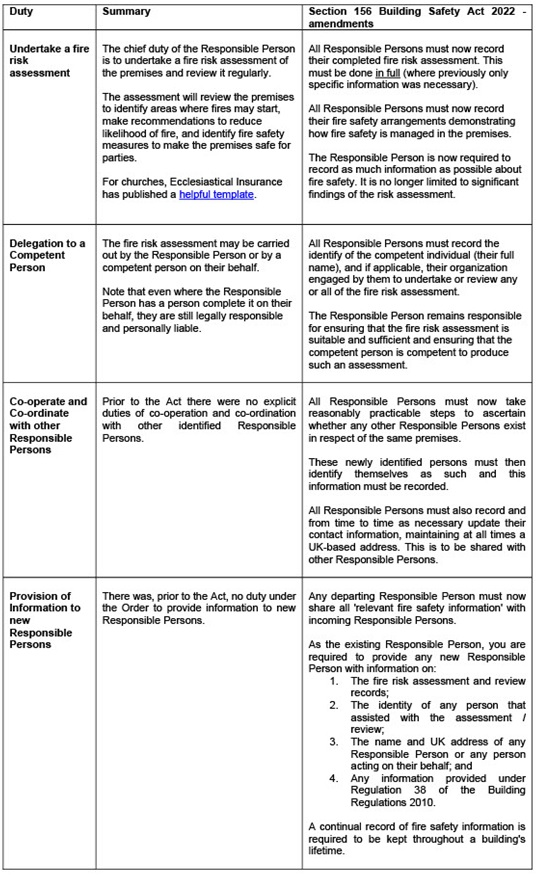Background
The Building Safety Bill received royal assent in April 2022, becoming the Building Safety Act 2022 ('the Building Safety Act'). This legislation made amendments to the Regulatory Reform (Fire Safety) Order 2005 ('the Fire Safety Order').
Section 156 of the Building Safety Act in particular focuses on fire responsibilities and their impact, it makes changes to the duties that a 'Responsible Person' (as defined below) must fulfil in respect of fire risk assessments and safety.
This article discusses the main implications for schools, churches, mosques, temples and other places of religious worship.
The Fire Safety Order
The Fire Safety Order sets out the regulatory framework for fire safety in non-domestic premises and certain communal areas of domestic premises in England and Wales including places of worship and educational establishments.
The Fire Safety Order places the duty of ensuring fire safety on a designated ‘Responsible Person.’ This individual is typically the person or entity that has control over the premises; they are responsible for implementing fire safety measures to keep people safe from fire.
'Responsible Person'
The Responsible Person is a legal entity created by the Fire Safety Order and is defined as follows in the legislation:

For a Church of England parish church, the Parochial Church Council will be the Responsible Person, absent some other arrangements made locally, not a member of the clergy, a churchwarden or a member of staff. Therefore fire safety matters should be approved by the PCC and not left to a churchwarden solely to get on with.
For another place of worship, the council or other body of trustees with the care and management of the premises is likely to be the Responsible Person and should act accordingly.
In the case of maintained schools, the governing body of the school will be the Responsible Person, and for an academy, the academy trust, unless the responsibility has been specifically delegated to a local governing board. Where it is delegated (such as under a scheme of delegation) the academy trust should put in place feedback mechanisms to ensure that its delegate is discharging its role properly.
Where premises are subject to a lease, the tenant which has exclusive possession will normally be the Responsible Person, but the lease ought to identify where responsibility lies. Where the let premises is integrated into a wider complex of buildings which remains under the control of the landlord care should be made to ensure that each party knows where responsibility lies. Detailed arrangements as to whose risk assessment will apply should be documented, as should responsibility for providing and servicing alarms and fire suppressing equipment. The insurer of the building should be consulted for their requirements to ensure that whatever is agreed does not conflict with the policy of insurance and that the insurer has been fully consulted about the proposed use of the building and the identity of the tenant.
Where premises are merely shared, for example for occasional lettings of a church hall, it will normally be the case that the Responsible Person will be the normal owner/manager of the buildings and the person taking hire of the building will sign-up to terms and conditions requiring observance to the school or church fire safety regulations. It would be disproportionate to expect the hirer to take that responsibility. However, where the hire is frequent and substantial – eg daily hire to a private nursery, it may be appropriate that the proprietor of the nursery – as the main occupier – takes on the Responsible Person role. Again, this should be documented.
Otherwise under the statutory definition, the Responsible Person will therefore generally fall into three categories:
- Employers in a workplace
In a workplace (which are premises or any parts of premises used by an employer and made available to employees as a place of work), you will be the Responsible Person if you are the employer, and the workplace is under your control. - People who exercise control of the premises
You may also be the Responsible Person if you are not an employer but exercise some degree of control over the premises and conduct business, trade, or some other undertaking from the premises. This may be the case where a place of worship, village hall, charity shop or scout hut is concerned, or otherwise where there is no traditional employer and employee relationship. - Owners
Where you own a commercial premises and neither of the above applies (i.e., the premises is not under someone else’s control) you will be the responsible person.
Even if you are not a Responsible Person as categorised above, you may be a ‘Duty Holder’ and therefore responsible for complying with the Fire Safety Order. This will be the case if you have an agreement in place which requires you to undertake maintenance or repair of the premises or their contents, fixtures, or fittings and/or makes you responsible for the safety of the premises. The extent of your responsibilities and duties under the Fire Safety Order will depend on the agreement you have in place.
Duties of the Responsible Person as amended by Section 156 Building Safety Act
To understand the core changes to the responsibilities of the Responsible Person we include a table below setting out the key duties and how, if at all, these have been changed by the recent legislation.

References:
Fire safety responsibilities under Section 156 of the Building Safety Act 2022 - GOV.UK (www.gov.uk)
Check your fire safety responsibilities under the Fire Safety Order - GOV.UK (www.gov.uk)
Help and advice
Should you wish any help and advice concerning issues raised by this article please contact us.

